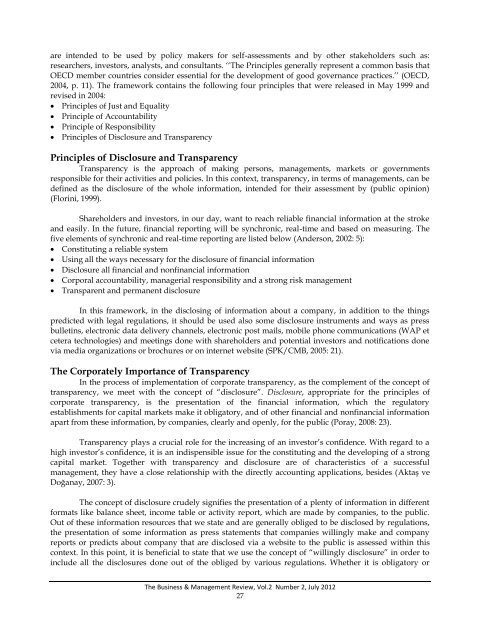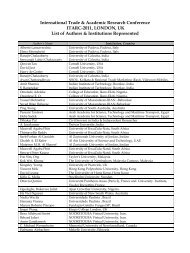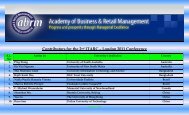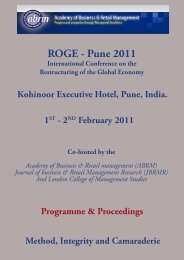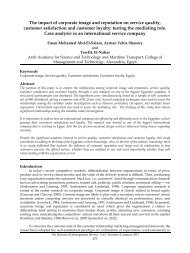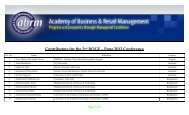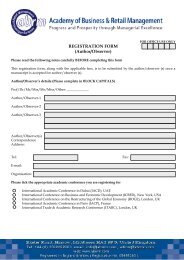THE BUSINESS & MANAGEMENT REVIEW - The Academy of ...
THE BUSINESS & MANAGEMENT REVIEW - The Academy of ...
THE BUSINESS & MANAGEMENT REVIEW - The Academy of ...
You also want an ePaper? Increase the reach of your titles
YUMPU automatically turns print PDFs into web optimized ePapers that Google loves.
are intended to be used by policy makers for self-assessments and by other stakeholders such as:<br />
researchers, investors, analysts, and consultants. ‘‘<strong>The</strong> Principles generally represent a common basis that<br />
OECD member countries consider essential for the development <strong>of</strong> good governance practices.’’ (OECD,<br />
2004, p. 11). <strong>The</strong> framework contains the following four principles that were released in May 1999 and<br />
revised in 2004:<br />
Principles <strong>of</strong> Just and Equality<br />
Principle <strong>of</strong> Accountability<br />
Principle <strong>of</strong> Responsibility<br />
Principles <strong>of</strong> Disclosure and Transparency<br />
Principles <strong>of</strong> Disclosure and Transparency<br />
Transparency is the approach <strong>of</strong> making persons, managements, markets or governments<br />
responsible for their activities and policies. In this context, transparency, in terms <strong>of</strong> managements, can be<br />
defined as the disclosure <strong>of</strong> the whole information, intended for their assessment by (public opinion)<br />
(Florini, 1999).<br />
Shareholders and investors, in our day, want to reach reliable financial information at the stroke<br />
and easily. In the future, financial reporting will be synchronic, real-time and based on measuring. <strong>The</strong><br />
five elements <strong>of</strong> synchronic and real-time reporting are listed below (Anderson, 2002: 5):<br />
Constituting a reliable system<br />
Using all the ways necessary for the disclosure <strong>of</strong> financial information<br />
Disclosure all financial and nonfinancial information<br />
Corporal accountability, managerial responsibility and a strong risk management<br />
Transparent and permanent disclosure<br />
In this framework, in the disclosing <strong>of</strong> information about a company, in addition to the things<br />
predicted with legal regulations, it should be used also some disclosure instruments and ways as press<br />
bulletins, electronic data delivery channels, electronic post mails, mobile phone communications (WAP et<br />
cetera technologies) and meetings done with shareholders and potential investors and notifications done<br />
via media organizations or brochures or on internet website (SPK/CMB, 2005: 21).<br />
<strong>The</strong> Corporately Importance <strong>of</strong> Transparency<br />
In the process <strong>of</strong> implementation <strong>of</strong> corporate transparency, as the complement <strong>of</strong> the concept <strong>of</strong><br />
transparency, we meet with the concept <strong>of</strong> “disclosure”. Disclosure, appropriate for the principles <strong>of</strong><br />
corporate transparency, is the presentation <strong>of</strong> the financial information, which the regulatory<br />
establishments for capital markets make it obligatory, and <strong>of</strong> other financial and nonfinancial information<br />
apart from these information, by companies, clearly and openly, for the public (Poray, 2008: 23).<br />
Transparency plays a crucial role for the increasing <strong>of</strong> an investor’s confidence. With regard to a<br />
high investor’s confidence, it is an indispensible issue for the constituting and the developing <strong>of</strong> a strong<br />
capital market. Together with transparency and disclosure are <strong>of</strong> characteristics <strong>of</strong> a successful<br />
management, they have a close relationship with the directly accounting applications, besides (Akta ve<br />
Doanay, 2007: 3).<br />
<strong>The</strong> concept <strong>of</strong> disclosure crudely signifies the presentation <strong>of</strong> a plenty <strong>of</strong> information in different<br />
formats like balance sheet, income table or activity report, which are made by companies, to the public.<br />
Out <strong>of</strong> these information resources that we state and are generally obliged to be disclosed by regulations,<br />
the presentation <strong>of</strong> some information as press statements that companies willingly make and company<br />
reports or predicts about company that are disclosed via a website to the public is assessed within this<br />
context. In this point, it is beneficial to state that we use the concept <strong>of</strong> “willingly disclosure” in order to<br />
include all the disclosures done out <strong>of</strong> the obliged by various regulations. Whether it is obligatory or<br />
<strong>The</strong> Business & Management Review, Vol.2 Number 2, July 2012<br />
27


